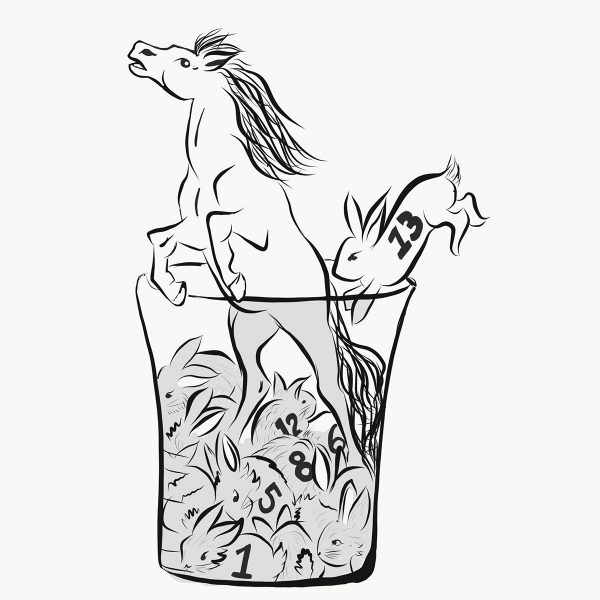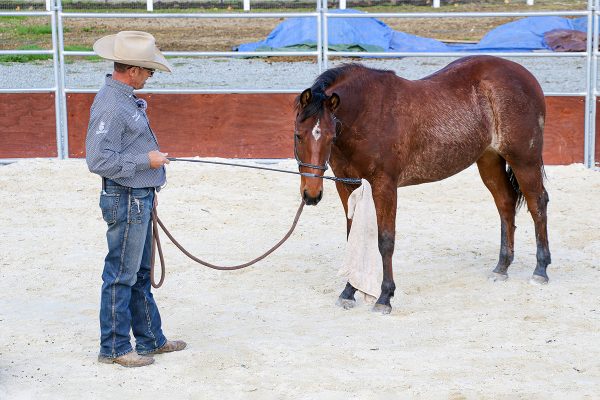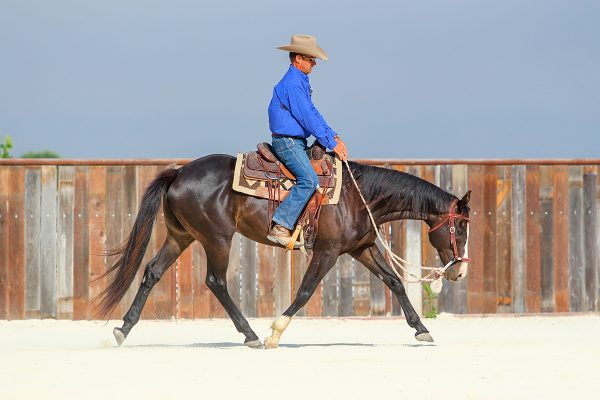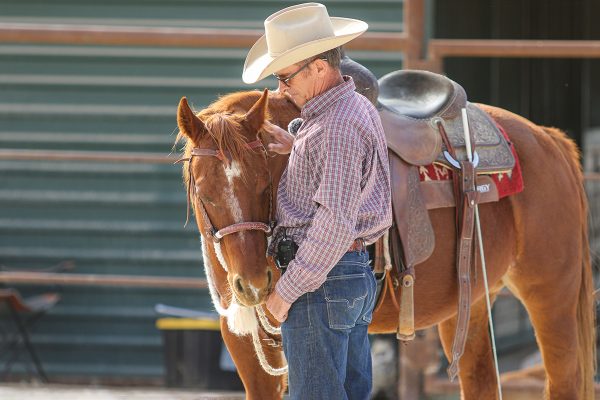Have you ever been anxious? If not before entering the show ring, then maybe because you lost your phone, or when you got lost. Whatever the cause, you were likely able to move on from that situation and relax again. That feeling of anxiety probably didn’t make you feel very good—you may have felt a pain in your stomach, become frantic, or maybe cried. Just like humans, horses exhibit most behavioral responses (bucking, bolting, rearing, etc.) because of their underlying levels of anxiety. Some horses are unable to fully relax, so they hold onto those feelings of worry and pain until they can’t hold it in any longer. That’s when the buck or bolt happens.

An attendee at my clinic in England a few years ago asked me, “What do you do with a crazy horse? One that just explodes out of nowhere?” I asked if she could give me an example.
She said: “My horse is crazy. We’ll be trail riding, and we’ll be riding along, and a rabbit will run out of the wet grass. My horse sees it, steps sideways, but doesn’t really do anything. Then we go along a bit further and another rabbit jumps out. Still no problem. Then another and another. He doesn’t really react to any of them. But then after an hour or so, after about 12 rabbits, one more rabbit jumps out and he freaks out and bucks me off. I told you—he is crazy!”
Over the years, I have heard many versions of this story where a horse just reacted “out of nowhere.” However, these outbursts do not come out of nowhere, but rather they grow from a steady buildup of anxiety. Therapists that work with people would call this trigger stacking. A trigger is something that causes worry to be created. Each trigger might be small, but all the triggers stacked up on top of each other create too much worry for our horses to handle.
I explained it to the clinic participant this way: When her horse saw the first rabbit it added a little bit of anxiety to the horse, but he was able to contain it. The second rabbit would have added a little more, but still controllable, then the third a little more, and so on. The horse could handle these minor increases of worry until the thirteenth rabbit.
“It’s obvious your horse has a 12-rabbit limit,” I said. “Up until then he can contain that amount of worry, but the thirteenth rabbit pushed him over the edge and the anxiety came out as a spook, spin, and buck.”
It’s important to remember that horse has their own “rabbit carrying” capacity. Some horses can only manage one rabbit, whereas some may be okay with many more.
Finding Your Horse’s Rabbit Capacity
You might be wondering, how many rabbits can my horse handle? The goal is to not find out! The only way you could find that out is if your horse has an explosion of bad behavior, which we want to avoid, especially if at a show or other important event. The goal is to make sure that your horse always stays under their limit for the number of rabbits they can handle.

Thankfully, the more you start emptying your horse’s worry cup the easier it becomes for him to stay relaxed. When a horse is relaxed and confident, you make much more progress during a training session then if your horse is worried and holding onto their rabbits. In that case, he’s distracted and can’t fully focus on what you’re trying to practice.
Keeping the Worry Cup Empty
The key to making sure your horse never fills up their worry cup is simple: Whenever your horse becomes a little bit worried or tense, immediately work on getting him to relax again. Relaxation will look different depending on where you’re currently at in the training process. Say you’re cantering, and your horse picks up a bit too much speed and begins to get worried. Bringing him back down to a walk to make sure he slows down and relaxes again is a step in the right direction. The wrong thing to do in this case would be to continue “riding through” his increased worry.
In another example, let’s say you’re leading your horse away from the barn heading towards the arena to ride, and he becomes tense, raises his head in the air, and begins whinnying towards his friends back at the barn. The best thing to do would be to bring his focus back to you by doing some light groundwork to make sure he’s not worked up before you hop on to ride. If he becomes settled, that’s a good sign his worry cup is empty, and you can continue toward the arena and the rest of your riding session. If he’s still worried, then your goals for the day’s session have now shifted. Now, it’s no longer about riding in the arena, it’s about making sure your horse’s worry cup is emptied before continuing on to the next objective.

If you hadn’t taken the time to make sure your horse was relaxed before leaving the barn, your horse would show up to the arena with a couple rabbits worth of worry in their cup, and you’d have to deal with those rabbits in the arena. It’s much easier to resolve things when they are small. It’s much harder to get your horse to relax once you’re sitting on his back.
This mindset, considering your horse’s levels of anxiety and tension and making sure they are relaxed above anything else, will help your horse both physically and mentally. However, the best side effect of constantly emptying your horse’s worry cup is that he will notice you’re aware of when he becomes upset or anxious. He can recognize that you notice his concern and that you’re doing everything you can to fix it, which will make him trust you. When you overlook those levels of concern, the horse becomes unsure of your ability to look out for him.
Emptying a Shared Horse’s Worry Cup
If you want to create a deeper connection and trust with your horse, emptying your horses worry cup consistently will ensure he knows you’re on their team. This can be difficult because there are often many people handling your horse if he is stabled somewhere else. If your horse’s mental well-being is a priority for you, then make sure to tell your trainer. If your trainer trusts you enough to ride your horse, they will also trust your decision to help your horse’s worry cup stay empty. Tell them about the 12 rabbits story, and explain that you want to make sure your horse is able to easily find relaxation. There are many methods to achieve this relaxation and your trainer can adapt this mindset into any discipline or experience level.

Your horse is there for you, so it’s your job to become an ambassador for your horse’s mental state and make sure his worry cup stays empty. This will help you and your horse enjoy stress-free time together and achieve great things. Watch the video below to find out more about the signs of tension and worry in a horse so you can fix things as they come up.
This article about your horse’s worry cup is a web exclusive issue for Young Rider magazine in partnership with Warwick Schiller. Click here to subscribe to Young Rider!


